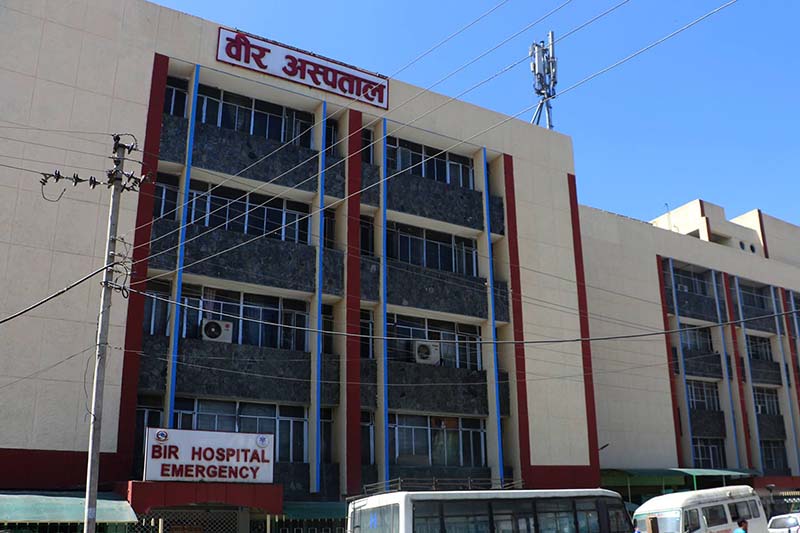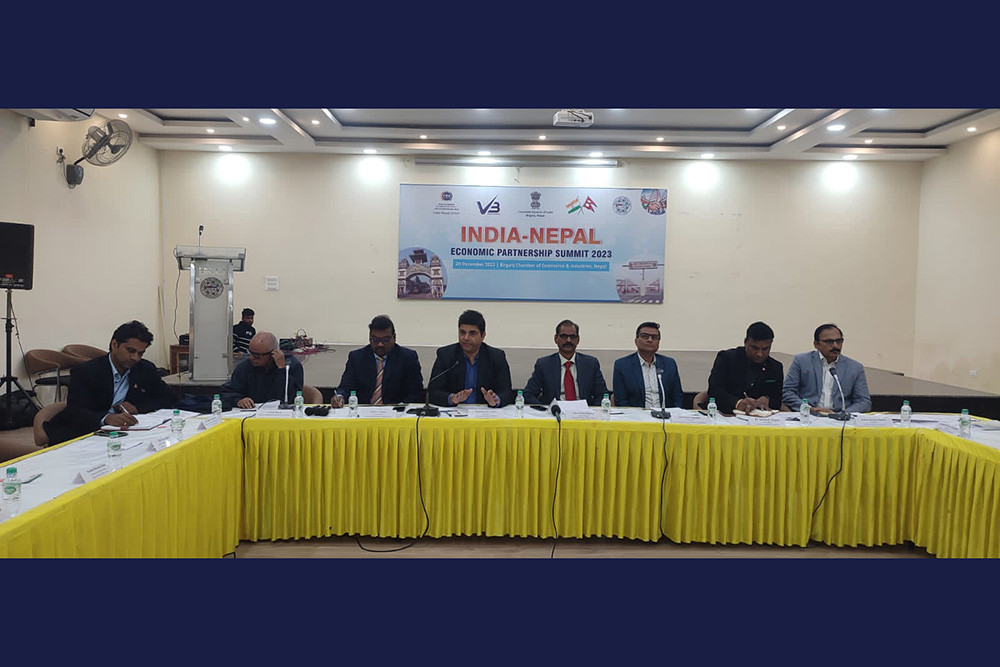
KATHMANDU: All the major hospitals in Kathmandu Valley have witnessed rising hospitalisations along with surging daily infections since the beginning of the new year.
Bir Hospital, one of the largest hospitals in Kathmandu, which was converted into a Covid 19 hospital, has witnessed growing hospitalisations in the past week.
The Ministry of Health and Population (MoHP) on Thursday reported 2,922 new cases of coronavirus infection.
Increase in hospitalisations, tests As per data released by the Ministry of Health and population on Thursday, Bir Hospital has 160 Covid patients. As more people are hospitalised, the COVID-19 testings have also rapidly increased. More than 200 persons come for Covid testings a day at the hospital, according to staff at Bir Hospital. The number of hospitalisations of Covid patients has also slightly increased at Patan Hospital. There are now 45 hospitalised Covid patients at Patan Hospital, according to the data released by MoHP. "Those coming for tests with PCR has increased to over 100 a day from 70 to 80," according to the staff at the hospital.
Health facilities improving The state of health facilities at hospitals came to the fore as a potential third wave of Covid 19 looms. In May last year, when the second wave raged, hospitals were forced to turn away patients due to a lack of beds, oxygen and ventilators. This time around, major hospitals in the Kathmandu Valley said they are more than capable of accommodating an increasing flow of patients. "We currently have 43 beds for COVID-19 patients and we can increase the bed number substantially as per the need," said Shanta Kumar Das, coordinator of the COVID-19 management committee at Tribhuvan University Teaching Hospital. The hospital has a new oxygen plant with a capacity of 2,000 litres per minute. "We also have set up liquid oxygen tanks with a capacity of 20,000 litres," Das said. Patan Hospital is also equipped with a new oxygen plant and has set aside 110 beds for COVID-19 patients. "The oxygen plant has the capacity of producing 260 cylinders a day," Shakya said, adding more beds can be supplied over need. Bracing for another wave of the pandemic, Bir Hospital is making sure about increasing the supply of oxygen. "We have the oxygen plant with a capacity of 150 cylinders per day, while we have separate liquid oxygen tanks with a capacity of 20,000 litres," said Shrestha. Bir Hospital has a separate building that can house 500 beds for COVID-19 patients in the worst-case scenario. "As many as 231 beds are currently functional," said Shrestha. "Of them, 103 are high dependency unit beds and 100 are intensive care unit beds." Doctors, however, cautioned that improving health facilities at hospitals might not be enough to handle a growing number of patients due to the highly infectious nature of the Omicron variant, which is believed to have driven the new wave of infections. "We should not be overconfident about our facilities, even though Omicron appears to be less lethal than the Delta variant which drove the second wave last year," said Shakya. Government officials said they were arranging the logistics over projected needs. "A rapid action plan is being prepared to tackle a new wave of the coronavirus," Surendra Chaurasiya, chief of the logistics management section of the Department of Health Services, said. "We're making our logistical arrangement based on this plan. At least, there is little possibility of an immediate oxygen shortage."
Lack of human resources highlighted Bir Hospital has hired 55 more medical officers and 152 nurses for COVID-19 patients in view of the third wave of coronavirus. "We need an additional 100 medical officers and 250 nurses if patients come to the full capacity of the 500-bed new building," said Shrestha. The hospital is coordinating with 21 provincial and other hospitals in different parts of the country. "I have heard of complaints about a potential shortage of human resources from most of these hospitals," Shrestha said. Shakya said he has a similar concern, noting that there might be "a severe shortage of human resources if health workers are infected in numbers." Despite an abundant stock of vaccine doses, the Nepali government has failed to accelerate the vaccination drive starting in late January last year. As of Wednesday, only 37.8% of the country's some 30 million population had been fully vaccinated. The authorities have re-imposed some restrictive measures to curb the spread of the virus, including banning public gatherings involving more than 25 people, closing schools and colleges, and vaccinating students aged 12-17. READ ALSO:
Increase in hospitalisations, tests As per data released by the Ministry of Health and population on Thursday, Bir Hospital has 160 Covid patients. As more people are hospitalised, the COVID-19 testings have also rapidly increased. More than 200 persons come for Covid testings a day at the hospital, according to staff at Bir Hospital. The number of hospitalisations of Covid patients has also slightly increased at Patan Hospital. There are now 45 hospitalised Covid patients at Patan Hospital, according to the data released by MoHP. "Those coming for tests with PCR has increased to over 100 a day from 70 to 80," according to the staff at the hospital.
Health facilities improving The state of health facilities at hospitals came to the fore as a potential third wave of Covid 19 looms. In May last year, when the second wave raged, hospitals were forced to turn away patients due to a lack of beds, oxygen and ventilators. This time around, major hospitals in the Kathmandu Valley said they are more than capable of accommodating an increasing flow of patients. "We currently have 43 beds for COVID-19 patients and we can increase the bed number substantially as per the need," said Shanta Kumar Das, coordinator of the COVID-19 management committee at Tribhuvan University Teaching Hospital. The hospital has a new oxygen plant with a capacity of 2,000 litres per minute. "We also have set up liquid oxygen tanks with a capacity of 20,000 litres," Das said. Patan Hospital is also equipped with a new oxygen plant and has set aside 110 beds for COVID-19 patients. "The oxygen plant has the capacity of producing 260 cylinders a day," Shakya said, adding more beds can be supplied over need. Bracing for another wave of the pandemic, Bir Hospital is making sure about increasing the supply of oxygen. "We have the oxygen plant with a capacity of 150 cylinders per day, while we have separate liquid oxygen tanks with a capacity of 20,000 litres," said Shrestha. Bir Hospital has a separate building that can house 500 beds for COVID-19 patients in the worst-case scenario. "As many as 231 beds are currently functional," said Shrestha. "Of them, 103 are high dependency unit beds and 100 are intensive care unit beds." Doctors, however, cautioned that improving health facilities at hospitals might not be enough to handle a growing number of patients due to the highly infectious nature of the Omicron variant, which is believed to have driven the new wave of infections. "We should not be overconfident about our facilities, even though Omicron appears to be less lethal than the Delta variant which drove the second wave last year," said Shakya. Government officials said they were arranging the logistics over projected needs. "A rapid action plan is being prepared to tackle a new wave of the coronavirus," Surendra Chaurasiya, chief of the logistics management section of the Department of Health Services, said. "We're making our logistical arrangement based on this plan. At least, there is little possibility of an immediate oxygen shortage."
Lack of human resources highlighted Bir Hospital has hired 55 more medical officers and 152 nurses for COVID-19 patients in view of the third wave of coronavirus. "We need an additional 100 medical officers and 250 nurses if patients come to the full capacity of the 500-bed new building," said Shrestha. The hospital is coordinating with 21 provincial and other hospitals in different parts of the country. "I have heard of complaints about a potential shortage of human resources from most of these hospitals," Shrestha said. Shakya said he has a similar concern, noting that there might be "a severe shortage of human resources if health workers are infected in numbers." Despite an abundant stock of vaccine doses, the Nepali government has failed to accelerate the vaccination drive starting in late January last year. As of Wednesday, only 37.8% of the country's some 30 million population had been fully vaccinated. The authorities have re-imposed some restrictive measures to curb the spread of the virus, including banning public gatherings involving more than 25 people, closing schools and colleges, and vaccinating students aged 12-17. READ ALSO:
Published Date: January 13, 2022, 12:00 am
Post Comment
E-Magazine
RELATED B360 National





